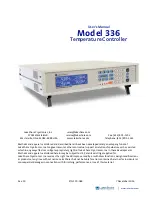
IOM-48
10
9. Reposition packing
fl
ange (Ranger (14))
(Pre mier Unlined (5)) over packing studs (21)
for Ranger and Premier Unlined. Reinstall
live-loaded packing components (Rang er (27)
(28) (29) 2 sets). Reengage both pack ing stud
nuts (22) for Ranger and Premier Un lined. Set
torque level on pack ing stud nuts as indicated
in IOM-Ranger QCT, IOM-Pre mier EZO, or
IOM-Premier Unlined body as sem bly (BA)
instructions.
10. Reorient body assembly (BA) with respect to
the actuator assembly (AA). Rejoin the body
assembly (BA) to the actuator assembly (AA)
as described in this section, V.I. Ensure prop er
plug (Ranger (6)) or disc (Premier (3.1)) po si-
tion prior to reinstalling lever arms (5). Ensure
that the lever arms (5) are “centered” within
the arm housing (4), and with respect to the
actuator stem linkage (8) (9) (10) (43) (44).
11. Recalibrate the unit (AA) (BA) and its positioner
((PA)).
D. Changing Failsafe Action
:
1. The Model 48 actuator (AA) is
fi
eld-re vers ible
for failsafe action with no additional parts
required.
2. It is possible that both of the following can
occur together for the degree of disassembly
undertaken:
a. Failsafe action reversed.
b. Change in actuator mounting position.
NOTE:
This section will be limited to the pro ce dures
for 2.a. above. If 2.b. is also desired, then it will be
necessary to reference Sub sec tion C. here in for
the added procedural steps as required.
This subsection will thus be limited as in di cat ed as
follows (reference Figures 6 – 9 herein for be gin-
ning and end graphic orientations).
3. To reverse actuator (AA) failsafe action ba si-
cal ly requires:
a. Moving lever arms (5) from left side of
valve’s stem (Ranger (7)) (Premier (3.2))
to right side, or vice versa. This is ac com-
plished by removing actuator assembly
(AA) from body assembly (BA) and ro tat ing
actuator (AA) 180° about the ac tu a tor’s
stem linkage (8) (9) (10) (43) (44). See
Figure 10 and Figure 11.
b. Rotating plug (Ranger (6)) or disc (Pre mier
(3.1)) by 90°; ie. from “closed” po si tion to
“open” position, or vice versa.
c. Reconnecting actuator (AA) to body (BA)
with lever arms (5) also rotated 180°.
NOTE:
Valve stem always goes CW to “close”,
viewed from stem-end.
4. Separate the actuator assembly (AA) from
the body assembly (BA) as described in this
Sec tion, V.B.1. through V.B.9.
5. Rotate plug (Ranger (6)) or disc (Premier (3.1))
position 90° to new failsafe position.
6. Slide actuator assembly (AA) that has been
rotated 180° back over the stem-end (Ranger
(7)) (Premier (3.2)). Align bolt holes between
arm housing (4) and valve yoke (12).
7. Reengage bolting (24) securing arm housing
(4) to yoke (12). Torque bolting (24) to 17-20
ft-lbs (23-27 N-m).
8. Ensure that the reinstalled lever arms (5) are
also rotated 180° in the same reference as the
actuator as sem bly (AA) was rotated.
(NOTE:
The repositioned arms (5) will appear to have
only changed relative position by 90° in an oth er
plane.)
Ensure the lever arms assembly (5)
is “centered” within the arm housing (4), and
with respect to the actuator stem (8) (9) (10)
(43) (44).
9. Rejoin the body assembly (BA) to the actuator
as sem bly (AA) as described in this Section,
V.I.
E. Diaphragm
Replacement:
1. Place unit assembly (AA) (BA) onto a
fl
at work
bench with actuator upper casing (1) on top
side; i.e. handwheel (58), if supplied, on top
side.
2. Ensure that all air pressure is released from
actuator assembly (AA) casing (1).
Product
Begin
End
Position Action Position Action
“A” ATO-FC “B“ ATC-FO
“C” ATO-FC “D” ATC-FO
“E”
ATO-FC
“F”
ATC-FO
Ranger QCT
“G”
ATO-FC
“H”
ATC-FO
“B” ATC-FO “A” ATO-FC
“D” ATC-FO “C” ATO-FC
“F”
ATC-FO
“E”
ATO-FC
“H”
ATC-FO
“G”
ATO-FC
Premier
EZO “A” ATO-FC “B” ATC-FO
or
“C” ATO-FC “D” ATC-FO
Premier
“B” ATC-FO “A” ATO-FC
Unlined
“D” ATC-FO “C” ATO-FC










































